Kaseya recently published its second annual IT Operations Benchmark Survey, which included results from 1,200 small and midsize companies (SMBs) representing over 50 industries and 20 countries. Here are several insights from the survey that are extremely valuable to the MSPs who are targeting these companies.
June 30, 2016
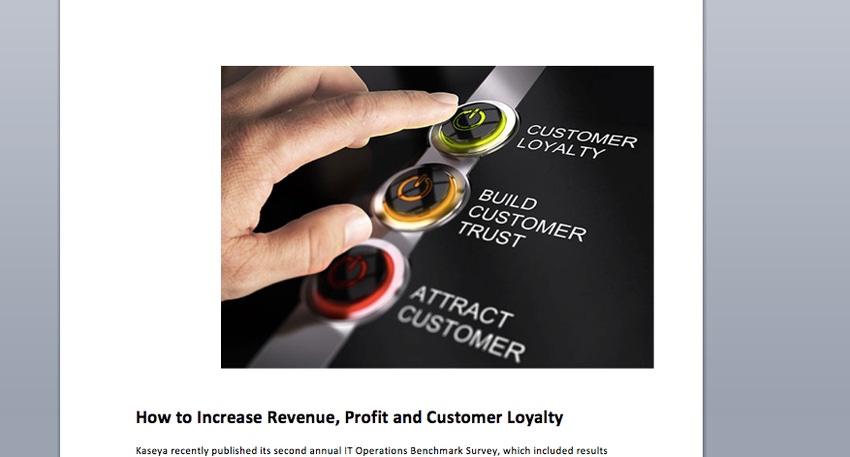
Sponsored Content
 Kaseya recently published its second annual IT Operations Benchmark Survey, which included results from 1,200 small and midsize companies (SMBs) representing over 50 industries and 20 countries.
Kaseya recently published its second annual IT Operations Benchmark Survey, which included results from 1,200 small and midsize companies (SMBs) representing over 50 industries and 20 countries.
I thought I would share several insights from the survey that are extremely valuable to the MSPs who are targeting these companies.
IT Maturity Model
Before I get into the highlights, though, I need to explain some terminology. The survey’s primary purpose is to help SMBs benchmark their experience and practices against their peers.
To that end, Kaseya developed its IT Management Maturity Model specifically for SMBs because existing IT maturity models were only relevant for much larger enterprises.
Maturity Levels simply measure how well the IT management function supports the IT needs of their business ��― from systems and service readiness, to technology choices (e.g., cloud services), to responsiveness and strategic alignment and business enablement.
This model, based on insights and feedback from our customers, consists of five levels:
REACTIVE: Responding to individual user challenges and requests
EFFICIENT: Having a systematic approach to solving known issues and dealing with daily tasks
PROACTIVE: Taking a proactive approach to IT management, automating repetitive tasks and many remedial actions
ALIGNED: Tracking and managing against service level agreements (SLAs) or availability/ performance expectations
STRATEGIC: Achieving IT operational excellence and taking a strategic role in driving business innovation
As you can see in Figure 1, most respondents are still in the Reactive IT maturity level, with less than 15 percent at the two highest levels of maturity.
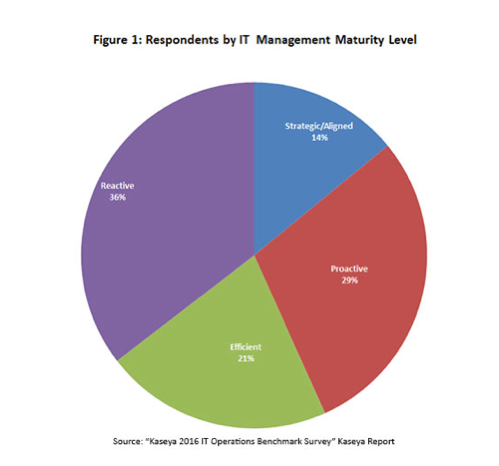
Bigger ≠ Better
It’s easy to assume the more Strategic IT Ops groups cluster in the larger companies. But that’s not the case. Companies of any size can achieve the highest levels of IT maturity. In fact, 82 percent of respondents in companies with 3K-5K employees are still at Reactive, Efficient, or Proactive levels of maturity.
However, IT Maturity levels are highly correlated to growth, as you can see in Figure 2. We can’t pretend that this correlation is causation, of course. However, it’s suggestive that – at least – a well-managed company focuses just as much attention on the best ways to organize, fund and staff its IT Ops group as it does on other essential business strategies.
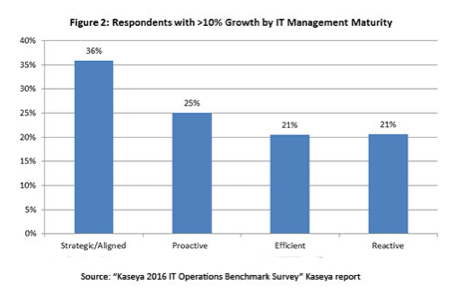
With those associations in mind, let’s turn to the findings that are most critical to MSPs targeting SMB clients.
Outsourced Services Help IT Groups Excel
On average, respondents are outsourcing over 6 distinct services – ranging from backup and recovery to virtual desktop services. Companies at higher maturity levels outsource on average 20% more services than those at lower levels. In fact, companies at either Strategic or Aligned maturity levels outsource on average 7 services, while companies at the Reactive only outsource on average 5.4 services.
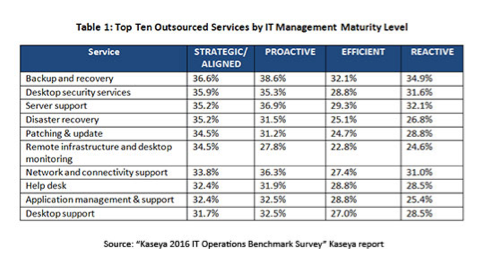
If you look forward twelve months, the picture flips in that the less mature IT groups are actively considering more outsourced services than their higher maturity peers. As Figure 3 illustrated, Reactive IT groups would increase their total outsourced services by 76% if they adopted all the services they were actively considering.
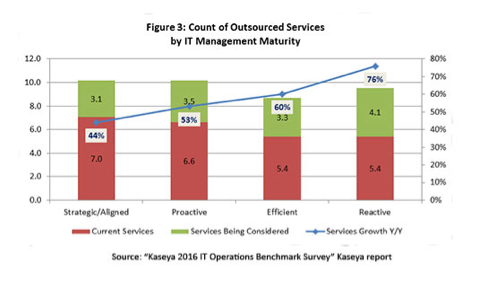
Why this matters: More and more SMBs are outsourcing more and more services. The data shows that this trend is ongoing and covers companies of all sizes and IT maturity levels. Of course, despite this strong trend, you may still encounter prospects who are leery of outsourcing for various reasons. In that situation, you can make a data-driven case that outsourcing operational functions frees internal IT staff to focus on IT initiatives that drive increased employee efficiency, customer satisfaction, and business growth. Outsourcing, in short, is a path to internal IT excellence.
Cloud Services Will Soon Be Mainstream
The more mature IT groups are currently using cloud services at a higher rate than their peers. For example, Strategic /Aligned IT groups leverage PaaS, IaaS, and SaaS solutions, as well as externally hosted private clouds, 50 percent more frequently than Reactive IT groups.
Furthermore, cloud services are the most popular services being considered by all groups over the next twelve months. And, again, the lower level IT maturity groups are looking to outsource at a higher rate on average than the higher level IT maturity groups.
In fact, combining ‘Currently Employed’ with ‘Considering in Next 12 Months,’ the delta between the highest and lowest levels of IT Management Maturity becomes much smaller, as seen in Table 2.
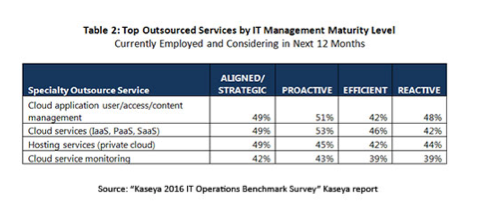
Why this matters: Sell cloud services. Seriously, you need to be evaluating which cloud services make sense for you to offer, and how to go to market with these services. Mature IT groups consider the cloud as a strategic enabler, allowing them to offload routine, repetitive tasks, scale at will, and focus their efforts on innovative IT projects to improve customer and end-user experience.
As important as offering cloud services directly, however, MSPs need to offer services that actively monitor and manage these cloud services. For example, SMBs are already realizing that Office 365 isn’t that easy to monitor and manage. The cost savings they forecasted are being eaten up in higher admin costs. This scenario will repeat again and again, increasing the urgency for third-party help in ensuring these cloud services deliver the performance and savings they are promising.
Automation + Tactics = Success
Another area of difference between higher maturity IT groups and lower maturity groups is how they prioritize IT automation, as well as the number of discrete tactics used to increase operational efficiency.
We asked respondents to select their Top 3 IT priorities for 2016. The list comprised of 24 different options (plus a place to list ‘Other’ priorities). When taking all responses together, ‘Increasing the level of IT Automation’ was among the top 5 priorities selected for all maturity groups except the Strategic/Aligned group. While we can’t say for sure, our theory is that the higher level maturity groups have already focused on automating everything and anything they could, making this a lower priority for 2016.
This theory is supported by another statistic – the number of different tactics and strategies leveraged by respondents to increase IT operational efficiency. On average, the more mature group used 36 percent more discrete tactics than the Reactive group (9.8 versus 7.2). Figure 4 shows the percentage of respondents in the highest and lowest tiers of maturity that use each of the tactics and strategies listed in the survey. IT automation is an ongoing process of continually finding and implementing new efficiencies throughout most of these tactics.
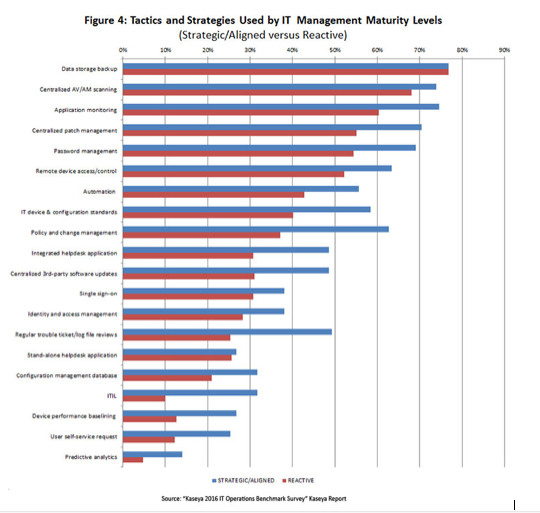
Why this matters: There is still a lot growth opportunity for MSPs in delivering basic RMM capabilities. Remember, over a third of respondents indicated they were only at the Reactive maturity stage, which means there are a lot of IT groups that are still in firefighting purgatory.
In addition, automation is like a super power, making everything simpler and easier. So MSPs who deliver these capabilities via powerful automation can make a compelling business case that works for their prospects, their existing clients and their own bottom line.
In particular, consider these services:
Policy and change management are particularly powerful when automated. Discovery, audit, software deployments (including third party software), patches, antivirus updates, backup, and more, can all be automated based on pre-defined policies that make sense for your clients and for your bottom line.
Security services such as password management, identity and access management and single sign-on make a big impact. These services are only going to grow in adoption as companies react to the escalating need for security measures beyond antivirus and anti-malware.
Centralized patch management and third-party software updates cries out for automation. The gap between the two cohorts in ‘standard’ practices for these two tactics is rather astounding.
Kaseya IT Complete for MSPs
As this study shows, technological requirements that were once the needs of only large enterprises are now becoming mainstream requirements for SMBs. The MSP market is experiencing significant change at a very rapid pace and that change is creating more opportunities for MSPs than ever before. The rate of consumption of MSP services by SMBs is expected to grow annually over 35% year over year through 2020.
In May, Kaseya introduced IT Complete for MSPs precisely to enable MSPs to take advantage of the new opportunities – and navigate around the new risks – of the changing MSP environment.
Kaseya IT Complete, as the industry’s first and only Unified MSP Growth Platform, provides MSPs with both solutions that help them RUN their business, as well as the most comprehensive offering of revenue-generating solutions to enable them to GROW their business, including next-generation RMM, cloud services monitoring, and network and systems monitoring solutions for complex, hybrid networks.
To learn more about how Kaseya IT Complete for MSPs can help your MSP, download Your Roadmap in an MSP 2.0 World: The Kaseya IT Complete Playbook.
Joining Kaseya in 2012, Miguel Lopez brings over 20 years of experience to his role as SVP, Managed Service Providers (MSPs). In this position, he consults daily with MSPs to help them solve their clients’ business problems with technology solutions. Prior to joining Kaseya, Miguel served as the director of consulting services for All Covered, a nationwide technology services company that is a division of Konica Minolta Business Solutions USA Inc. In 2008, All Covered acquired NetCor Technologies, a leading MSP that Miguel founded and managed since 1997. NetCor specialized in serving highly regulated industries such as healthcare, CPAs, law firms and retail companies.
You May Also Like
